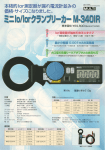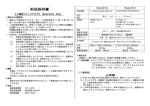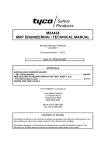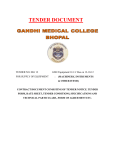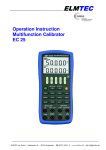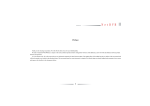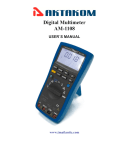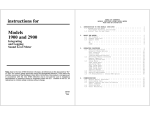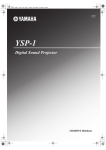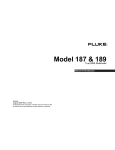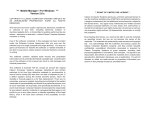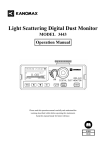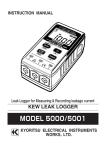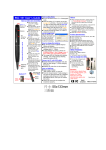Download victor 8145b
Transcript
DUAL DISPLAY MULTIMETER USER’S MANUAL CAUTION THIS IS AN IEC SAFETY CLASS 1 PRODUCT. THE GROUND WIRE IN THE LINE CORD MUST BE CONNECTED FOR SAFETY. WARRANTY Our company warrants to the original purchaser that each product it manufactures will be free from defects in material and workmanship under normal use and service for a period of one year from date of purchase. Our company’s warranty does not apply to fuses, test leads or any product which, in our company’s opinion, has been misused, altered, or damaged by accident or abnormal conditions of operation or handling. To obtain warranty service, contact the nearest Service Center or send the product, with a description of the difficulty, and postage prepaid, to the nearest Service Center. We assume no risk for the damage in transit. We will, at its option, repair or replace the defective product free of charge or refund your purchase price. However, if we determine that the failure was caused by misuse, alterations, accident or abnormal condition of operation or handing, you will be billed for the repair and the repaired product will be returned to you transportation prepaid. SHIPPING TO MANUFACTURER FOR REPAIR OR ADJUSTMENT All shipment of our company’s instruments should be made via United Parcel Service or “Best Way” prepaid. The instrument should be shipped in the original carton; or if it is not available, use any suitable container that is rigid and of adequate size. If a substitute container is used, the instrument should be wrapped in paper and surrounded with at least four inches of excelsior or similar shock-absorbing material. CLAIM FOR DAMAGE IN SHIPMENT TO ORIGINAL PURCHASER The instrument should be thoroughly inspected immediately upon original delivery to purchaser. All material in the container should be checked against the enclosed packing list. The manufacturer will not be responsible for shortages against the packing sheet unless notified immediately. If the instrument is damaged in any way, a claim should be filed with the carrier immediately. (To obtain a quotation to repair shipment damage, contact the nearest Service Center.) Final claim and negotiations with the carrier must be completed by the customer. 1 Section 1 Introduction INTRODUCING THE DUAL DISPLAY MULTIMETER In this manual, “WARNING” is reserved for conditions and actions that pose hazard(s) to the user; “CAUTION” is reserved for conditions and actions that may damage your meter. NOTE This manual contains information and warnings that must be followed to ensure safe operation and retain the meter in safe condition. WARNING READ THE “MULTIMETER SAFETY” SHEET BEFORE USING THE METER. The Dual Display Multimeter is a 5-digit high resolution mode. The meter is designed for bench-top. The features provided by the meter are: l A dual, Liquid Crystal, Display that allows two properties of an input signal to be displayed at the same time l True rms AC. l 30 MHz in frequency measurement l 10µV sensitivity in volts DC l Decibels with variable reference impedance measurement capability. l A compare mode to determine if a measurement is within, above, or below a designated range. l Slow and Fast selectable count resolution, with reading speeds of 3 and 6 reading per second, respectively. l Built-in self-tests with closed-case calibration (no internal calibration adjustment). l Isolation of Universal Serial Bus(USB) Port l Remote Control, display, record, Data Analysis, print with computer. WHERE TO GO FROM HERE This manual has been organized to assist you in getting started quickly. It is not necessary for you to read the entire manual before using the meter effectively. However, we recommend that you do so in order to use your meter to its full advantage. Begin by scanning the Table of Contents to familiarize yourself with the organization of the manual. Then, read Section 2, “GETTING STARTED”. Refer to the appropriate section of the manual as needed. The contents of each section are summarized below. SECTION 1. INTRODUCTION Introduces the Dual Display Multimeter, describing its features and users manual. SECTION 2. GETTING STARTED Explains how to prepare the meter for operation and get started quickly taking basic measurements from the front panel. SECTION 3. OPERATING THE METER FROM THE FRONT PANEL Provides a complete description of each operation that can be performed using the pushbuttons on the front panel. Section 3 is organized so that related operations and functions are grouped together. SECTION 4. MAINTENANCE Describes how to perform basic maintenance and how to replacing fuses as order SECTION 5. CALIBRATION Introduces the required equipment, ambient environment station for calibration and the process of calibration. SECTION 6. SPECIFICATIONS MULTIMETER SAFETY The Dual Display Multimeter has been designed and tested according to IEC Publication 1010 Safety Requirements for Electronic Measuring Apparatus. This manual contains information and warnings 2 which must be followed to ensure safe operation and retain the meter in safe condition. Some common international electrical symbols used in this manual are shown below. ○ OFF(power) DANGEROUS SWITCH POSITION VOLTAGE ON(power) EARTH GROUND SWITCH POSITION ~ AC-ALTERNATING WARNING INFORMATION CURRENT DC-DIRECT CURRENT Before using the meter, read the following safety information carefully. l Avoid working alone. l Follow all safety procedures for equipment being tested. l Inspect the test leads for damaged insulation or exposed metal. Check test lead continuity. Damaged leads should be replaced. l Be sure the meter is in good operating condition. l Select the proper function for your measurement. l To avoid electrical shock, display “ ‘ when working above 30V dc or 30V ac RMS. l Disconnect the live test lead (VΩ ) before disconnecting the common test lead (COM). l Disconnect the power and discharge high-voltage capacitors before testing in Ω, and . l When making a current measurement, turn the circuit power off before connecting the meter in the circuit. l Check meter fuses before measuring transformer secondary or motor winding current; (See Section 4, “MAINTENANCE”) An open fuse may allow high voltage build-up, which is potentially hazardous. Section 2 Getting Started INTRODUCTION Section 2 explains how to prepare the meter for operation, discusses general operating features, and walks you through the basics of taking some common measurements, GETTING STARTED Unpacking and Inspecting the Meter Carefully remove the meter from its shipping container and inspect it for possible damage or missing items. If the meter is damaged or something is missing, contact the place of purchase immediately. Save the container and packing material in case you have to return the meter. Front Panel and Rear Panel The front panel (shown in Figure 2-1) has three main elements: the input terminals on the right, the display and the pushbuttons. The pushbuttons are used to select major functions, ranging operations, and function modifiers. These 8145B DUAL DISPLAY MULTIMETER elements are described in detail DCV DCA in Section 3. ACV ACA FREQ 10A FUSED 1000V 750V dBm mA REL MN MX COMP SHIFT RATE HOLD 500mA 250V FAST FUSE RANGE POWER 1 ON 0 OFF AUTO 3 ALL INPUTS 1KV MAX MAX Figure 2-1. Front Panel The rear panel (shown in Figure 2-2) contains the power-line cord connector, communication interface, the Serial Number Label. USB TO AVOID SHOCK HAZARD, CONNECT THE INSTRUMENT POWER CORD TO A POWER RECEPTACLE WITH EARTH GROUND. THERE ARE NO PARTS TO DISASSEMBLE, NO MECHANICAL ADJUSTMENTS TO MAKE, IT IS DISALLOWED TO OPEN THE CASE. 220V AC 50Hz Figure 2-2. Rear Panel ADJUSTING THE HANDLE For bench-top use, the handle can be positioned to provide different viewing angles. To adjust its position, pull the ends out to a hard stop and rotate it to a position. To remove the handle, adjust it to the vertical stop position and pull the ends all the way out. POWER CAUTION TO AVOID SHOCK HAZARD, CONNECT THE INSTRUMENT POWER CORD TO A POWER RECEPTACLE WITH EARTH GROUND. NOTE Apply the rated voltage and frequency to the meter as marked on the rear panel of the meter. TURING THE METER ON To turn the meter on, press the POWER button located on the lower-left of the front panel. If you turn the meter off, you must wait five seconds before turning the meter back on. If you do not, the meter will not power-up. When the meter is turned on, the full screen displays light while the instrument performs an internal self-test of its digital circuitry. These tests check RAM, ROM, A/D, and the display. The meter has passed all tests and is ready for normal operation if an error code is not displayed. After the meter completes the power-up sequence, it assumes the power-up measurement configuration stored in non-volatile memory. The power-up configuration set at the factory is shown in Table 3-6. (To change the power-up configuration, refer to “CHANGING THE POWER-UP CONFIGURATION” in Section 3.) USING THE PUSHBUTTONS The pushbuttons on the front panel select meter functions and operations. A summary of basic pushbutton operations is shown in Figure2-3. FUNCTION BUTTONS Press to Select a Function FUNCTION M ODIFIER BUTTONS Press to Select a M odifier M ode DCV DCA ACV ACA FREQ REL MN MX COM P SHIFT RATE HOLD dBm RANGE BUTTONS Press to Select a Range BACK LIGHT Press in to Power-up RANGE PO W ER 1 ON 0 O FF AUTO Press to Step Through M easurem ent Rate(Slow,Fast) Figure 2-3. Summary of Basic Pushbutton Operations Pushbuttons can be used in two ways. You can: l Press a single button to select a function or operation. EXAMPLE: Press ACV to select volts ac function. l Press a combination of buttons, one after the other. EXAMPLE: Press ACV to select volts ac function, and then press REL to select the decibels 4 modifier. For more details on the uses of each button, refer to Section 3, “OPERATION THE METER FROM THE FRONT PANEL.” SELECTING A MEASUREMENT RANGE Measurement ranges can be selected automatically by the meter in “autorange” or manually by the user. In the autorange mode, the meter selects the appropriate range for the measurement reading. To manually select a range, press AUTO to toggle in (and out) of the manual ranging mode, or press or . In the manual range mode, press or to up range or down range to the desired range. For more details on ranging, refer to “RANGING” in Section 3. TAKING SOME BASIC MEASUREMENTS WARNING READ “MULTIMETER SAFETY” BEFORE OPERATING THIS METER. The following procedures describe the basics of taking common measurements from the front panel. These procedures are provided for the user who needs to get started quickly, but dose not want to read the rest of the manual at this time. However, in order to take full advantage of your meter, you should read the remainder of this manual carefully and completely. WARNING TO AVOID ELECTRICAL SHOCK OR DAMAGE TO THE METER, DO NOT APPLY MORE THAN 1000V (PEAK) BETWEEN ANY TERMINAL AND EARTH GROUND. THE METER IS PROTECTED AGAINST OVERLOADS UP TO THE LIMITS SHOWN IN TABLE 3-1. EXCEEDING THESE LIMITS POSES A HAZARD TO THE METER AND OPERATOR. Measuring Voltage, Resistance, or Frequency To measure voltage, resistance, or frequency, press the desired function button and connect the test leads as shown in Figure 2-4. The meter will select the appropriate range in the autorange mode. Measuring Current To measure current, insert the red test lead in the mA input terminal for currents up to 330mA or in the 10A input terminal for higher current, and insert the black test lead in the COM terminal. Connect the test leads as shown in Figure 2-5. mA 10A FUSED 1000V 750V MAX 500mA 250V FAST FUSE ALL INPUTS 1KV MAX DC Voltage,Pesistance or AC Voltage Figure 2-4. Measuring DC Voltage, Resistance, AC Voltage 10A FUSED A CURRENT SOURCE 1000V 750V mA mA 500mA 250V FAST FUSE MAX NOTE After measuring high current using the 10A input, thermal voltages are generated that may create errors when making low-level dc measurements of volts, current, or ohms. To make the most accurate measurements, allow up to ten minutes for the thermals to settle out. ALL INPUTS 1KV MAX Figure2-5. Measuring Current Diode/Continuity Testing The continuity test determines whether a circuit is intact (i.e., has a resistance less than about 150Ω). To perform a continuity test, press , and connect the test leads as shown in Figure 2-6. The beeper emits a continuous beep when the input drops below 150Ω (Beep condition can be changed, refer to “Changing the Power-UP Configuration” later in Section 3), and the readings for the test circuit are displayed. 10A FUSED + 1000V 750V MAX - TEST CIRCUIT mA 500mA 250V FAST FUSE ALL INPUTS 1KV MAX 5 The diode test measures the forward voltage of a semiconductor junction at approximately 0.8mA. Readings are displayed in the 3V range at the fast measurement rates. “OL” is displayed for voltages above 2.0V. Under normal measurement condition, the positive pole of diode is connected with the black test lead. 10A FUSED 1000V 750V MAX mA To perform a diode or transistor junction test, press to select the diode function. Then connect the test leads across the diode as shown in Figure 2-7. Notice how the test leads are placed. Reversing the polarity will reverse-bias the diode. 500mA 250V FAST FUSE ALL INPUTS 1KV MAX Figure 2-7. Diode Testing dBm (Decibels) measure The decibels modifier takes an ac voltage measurement, converts it to dBm (measure of decibels relative to one milliwatt), and displays the result on the primary display. Connect the test leads as shown in Figure 2-4. Press dBm to toggle in and out of the decibels mode. When the decibels mode is selected, “dBm” is shown on the primary display, AC voltage value is shown on the secondary display. Decibels can be selected only when ac voltage function is selected. Decibels are always displayed in a single, fixed range with 0.01 dB resolution. Press the AUTO toggle in and out autorange, you can also press the . and change range manually. A voltage measurement is converted to dBm using the following formula: dBm = 10*lg (1000*value2/reference impedance) where “value” is the measurement value, and displayed on the secondary display. The reference impedance can be changed. (Refer to “Changing the Power-UP Configuration” later in Section 3). Communication Interface The real time measured value can be transmitted to the computer by the devote USB cable and the VICTORVIEW_8145B software (refer to “using the communication function”in section 3). SECTION 3 Operating the Meter from the Front Panel INTRODUCTION Section 3 explains how to operate the meter from the front panel. FRONT PANEL OPERATIONS The following operations can be performed from the front panel: l Select a measurement function ( DCV, ACV, DCA, ACA, Ω, FREQ, dBm and ) l Select function modifiers that cause the meter to display relative readings (REL), minimum ,maximum or average values (MN MX) l Enter the Touch Hold mode (HOLD) to hold a reading on the display l Set Measurement Rate (RATE), change the rate as “F”(Fast) or “S”(Slow) l Take a measurement and compare (COMP) it to a setting value l Select the manual or autorange mode (AUTO), up range or down range manually to desired range l Turn on or turn off the back light (when arrive the setting time the back light can automatically off) l Power-on or off the power supply (POWER) 6 These operations are described in remainder of Section 3. DISPLAY The meter has a 5-digit, Liquid Crystal Display (Primary Display) and a 4-digit, Liquid Crystal Display (Secondary Display). The display shows measurement readings, measurement units and messages. As shown in Figure 3-1. Calibration state Autorange Hold Reading Rate MIN MAX Modifier High Voltage Secondary Display Time Function and Unit Annunciators Relative Modifier Primary Display Save Continuity Test Diode Test Figure 3-1. Display Annunciators Amperes Input Terminal. For Current Measurements up to 10A continuous INPUT TERMINALS The input terminals, as shown in Figure 3-2, are located on the right of the front panel The meter is protected against overloads up to the limits shown in Table 3-1. Exceeding these limits poses a hazard to both the meter and operator. Volts, Ohms, Diode Test input Terminal 10A FUSED 1000V 750V MAX mA 500mA 250V FAST FUSE Milliamperes Input Terminal. For Current Measurements up to 500mA ALL INPUTS 1KV MAX Common Terminal. Retern Terminal for all Measurements Figure 3-2. Input Terminals Table 3-1. Input Limits FUNCTION INPUT TERMINALS MAXIMUM INPUT V VΩ 1000V dc on all ranges V ~, FREQ and dBm VΩ mA and mA ~ and COM and COM 750V ac rms,1000V peak on all ranges mA and COM 500mA dc or ac rms A ~ and A ~ 10A and COM 10A dc or ac rms Ω VΩ 250V dc or ac rms on all ranges VΩ All Functions and COM and COM Any terminal to earth 250V dc or ac rms on all ranges 1000V dc or ac peak SELECTING A MEASUREMENT FUNCTION Press a function button, as shown in Figure 3-3, to select a measurement function. When you select a function, annunciators turn on to indicate the function selected. Rang and full scale values are summarized in Table 3-2 for voltage, current, ohms and frequency V o lts D C Am ps D C R e s is ta n c e D C V D C A AC V AC A F re q u e n c y A m ps AC V o lts A C FR EQ C o n tin u ity dB m dB m D io d e D CV A CV D C A A C A FR EQ R E L M N M X C O M P S H IF T R ATE H O LD dB m R A N G E P OW ER 1 O N 0 OFF AU TO r e a d i n g r a te Figure 3-3. Function Select Buttons Table 3-2. Voltage, Current, Ohms and Frequency Rang and Full Scale Value 7 FUNCITION V ~ and V mA ~ and mA A ~ and A Resistance Frequency ANGING (AUTO, , RANG FULL SCALE 300mV 330.00mV 3V 3.3000V 30V 33.000 V 300 V 330.00 V 1000V* 1100.0 V* 0.3mA** 0.33000 mA** 3mA** 3.3000 mA** 30mA 33.000 mA 300 mA 330.00 mA 10A 11.000A 300Ω 330.00Ω 3KΩ 3.3000 KΩ 30 KΩ 33.000 KΩ 300 KΩ 330.00 KΩ 3MΩ 3.3000 MΩ 30 MΩ 33.000 MΩ 100 MΩ 110 MΩ 300Hz 330.00 Hz 3KHz 3.3000 KHz 30KHz 33.000 KHz 300KHz 330.00 KHz 3MHz 3.3000 MHz 30MHz / INFORMATION *760V ac rms **AC current have not 0.3mA and 3mA range 30MHz range have not full scale ) Ranging operations are performed using the AUTO, and buttons (see Figure 3-4). Autoranging When you are in the autorange mode, the “AUTO” annunciator is lit. In autorange, the meter automatically selects the next higher range when a reading is P ress to To ggle In an d O ut of A utorange P res s to E n ter M anual R ange a nd D ow n R ange P ress to E n ter M anual R ange a nd U p R a nge greater than full scale. If no higher range is available, “OL” (overload) is displayed. The AUTO meter automatically selects a lower range when a reading is less than approximately 10% of the selected range. D CV D CA A CV A CA F R EQ RE L M N MX CO M P SH IFT R AT E HO LD d Bm Figure 3-4. Range Selection Butons R A N GE P O W ER 1 ON 0 O FF A UT O 读数速率键 Manual Ranging Press AUTO to toggle in and out of manual ranging. The range you are in when you enter the manual range mode becomes the selected range. In manual range, the meter remains in the selected range regardless of input. Press AUTO to toggle back to autoranging. Press to up range. If the is pressed when the meter is still in autorange, manual ranging is selected, the “AUTO” annunciator turns off, and the next higher range is selected (if there is one). Press to down range. If the is pressed when the meter is still in autorange, manual ranging is selected, the “AUTO” annunciator turns off, and the next lower range is selected (if there is one). When one function of Volts DC, Amps DC, Volts AC, Amps AC, Resistance or FREQ is selected, the selected range is displayed on the secondary display. 8 MEASURING FREQUENCY ( FREQ ) Press the FREQ button to select the frequency function, the frequency is displayed on the primary display and the selected range is displayed on the secondary display. Select the rang manually or automatically Frequency Measurement Rates The rate at which frequency measurements are taken is selected by the meter automatically, when the frequency function has been selected, press RATE has no effect on the frequency update rate. Frequency Sensitivity Selection Before a frequency measurement is started, the amplitude of the input signal is sampled and the optimum ac voltage range is selected automatically. For more information refer to the Section 6 for ac voltage sensitivity. The input signal sensitivity is based on sine waveforms. If the input signal is below the required level, the frequency will be displayed as zero. If the measurements are unstable, the input signal may be near the threshold level. SELECT A FUNCTION MODIFIER ( REL , HOLD , MNMX , COMP ) Selec ting a function modifier causes the meter to perform an action on an input (e.g., convert to relative reading mode or compare to another value) before a reading is displayed. To use a function modifier, press a function button to select a primary function, and then press a function modifier button. See Figure 3-5 REL (Relative Readings) Modifier Press REL to select the relative modifier. When the relative modifier is selected: the last valid reading is stored as the relative base and displayed on the secondary display. The reading on the primary display is always the difference between the relative base and an input measurement, and the “△” annunciator turn on. REL=present reading - relative base For example, if the relative base is 15.000V, and the present reading is 14.100V, the display will show -0.900V. WARING REMEMBER, A RELATIVE READING MAY NOT INDICATE THE PRESENCE OF DANGEROUS VOLTAGES AT THE INPUT CONNECTORS OR TEST LEADS. USE CAUTION TO AVOID ELECTRICAL SHOCK OR DAMAGE TO THE METER. Press REL again, the relative base is displayed on the secondary display. The reading on the primary display is REL%, and the “%” annunciator turn on simultaneous. M N M X M o d i f ie r C o m p a r e M o d i f ie r R e l a t iv e M o d if i e r REL MN MX COMP T o u c h H o l d M o d if i e r H O LD DCV ACV DCA ACA FR EQ REL MN MX CO M P S H IF T R A TE HO LD dBm RANGE P OW ER 1 ON 0 OFF AU TO 读 数 速 率 键 F ig u r e 3 - 5 . F u n c t io n M o d if i e r S e l e c t i o n B u t t o n s present reading-relative base REL%= relative base ×100% For example, if the relative base is 15.000V, and the present reading is 14.100V, the display will show -6%. Press REL again to exit the relative modifier. NOTE The relative modifier cannot be selected if the display shows “OL” or is blank. (The display would be blank, for example, because of range changes.) Selecting the relative modifier (REL) turns off autoranging and locks in the present range. Make sure you are in the correct range before selecting the relative modifier. If you press other buttons after the relative modifier has been selected, you will automatically exit REL. HOLD (Touch Hold) Modifier 9 The Touch Hold modifier allows you to hold the measurement reading on the display. Press HOLD to select the Touch Hold modifier. When Touch Hold is selected, “HOLD” annunciator is lit on, and the beeper emits a single beep. Press HOLD again to exit Touch Hold modifier, and the beeper emits a single beep. MN MX AVG (Minimum Maximum Average) Modifier The MN MX modifier causes the meter to store the minimum and maximum inputs measured since the MN MX AVG modifier was selected. Press MN MX to select the MN MX AVG modifier. When the MN MX AVG modifier is first selected, the minimum, maximum and average values are set to the displayed reading and the “MAX” annunciator lights, once the maximum value showed on the primary display, the beeper emits a single beep. Press MN MX again to display the minimum reading and the “MIN” annunciator lights, once the minimum value showed on the primary display, the beeper emits a single beep. Press MN MX again to display the average reading on the primary display (“AVG” annunciator lights). Each subsequent press the MN MX button toggles among the minimum, maximum and average measurements taken. The measurement reading displayed on the secondary display. To exit the MN MX AVG modifier, press and hold down the MN MX button for two seconds or press other function buttons. Selecting the MN MX AVG modifier turns off autoranging and locks in the present range. Make sure you are in the correct range before selecting the MN MX AVG modifier. COMP (Compare) Modifier The compare function (COMP) provides an easy way to determine if a reading falls within a designated range of values. In the compare mode, the meter displays a reading in the secondary display and indicates in the primary display if that value is lower (CO-LO) than, higher (CO-HI) than, or within a range (PASS) you selected, if the reading lower or higher, the beeper emits a continuous tone. Compare Modifier can be used under dc voltage, ac voltage, dc current, ac current and omh function, in compare mode, the meter is in manually range mode.. Following the step to enter Compare Modifier l Select a function and a range l Press COMP to toggle in Compare Modifier l Before selecting the compare function, set the high and low compare point first, when compare modifier selected, “MAX” annunciator lights, and the leftmost digit on the primary display is flashing, then can set the high point, press AUTO to select the digit to be set, each press AUTO causes the digit to the right to be selected and flashing, press or to up or down the flashing digit. Press the COMP again, “MIN” annunciator lights, and the leftmost digit on the primary display is flashing, then can set the low point, press AUTO to select the digit to be set, each press AUTO causes the digit to the right to be selected and flashing, press or to up or down the flashing digit. Each subsequent press the COMP button toggles between high set, low set and compare measurements taken. To exit the Compare Modifier, press and hold down the COMP button for two seconds or press other function buttons. Selecting the Compare Modifier turns off autoranging and locks in the present range. Make sure you are in the correct range before selecting the Compare Modifier. The function modifier is relative to the measurement function refer to the Table 3-5 Table 3-5. function modifier and measurement function FUN. Modifier REL HOLD MNMX COMP DCV √ √ √ √ ACV √ √ √ √ DCA √ √ √ √ Function 10 ACA √ √ √ √ Ω √ √ √ √ √ FREQ √ √ √ dBm SELECTING A MEASUREMENT RATE (RATE) The meter takes measurements at one of two, user-selectable rates: slow and fast. The rate selected is indicated by “S”, “F” on the display. Press the RATE to change the measurement rates at “S” or “F”. The selected rate applies to DCV、 DCA、 Ω、ACV、ACA、dBm. Note: l In Diode and Continuity Testing, the default rate is “F” l In 30M Ω and 300M Ω rang, the default rate is “S” Connect with the USB Plug the one end of the devote USB cable to the communication connector on the real panel, plug the other end of the cable to the USB port of the computer, running the devote DMMVIEW_8145B software, set the corresponding connector port to achieve online. When success, the COMM annunciator is lit on, the instrument transmits measured value and state to computer, thus, the computer can remote Control, display, record, Data Analysis, print all the measurement process. use the software stop the communication, the instrument stop transmit measured value and the COMM annunciator disappear. POWER-UP CONFIGURATION Factory Setting of Power-Up Configuration When the meter is turned on and completes the power-up sequence, it assumes its power-up configuration. The power-up configuration set at the factory is shown in Table3-6. Table 3-6. Power-Up Configuration Set at Factory PARAMETER CONFIGURATIONS REMARK Function Setting DC volt(DCV) Range Mode Autorange(AUTO) Reading Rate Slow(S) Reference Impedance( for dBm) 600Ω Compare set value 0 MIN/MAX/AVG 0 Relative Base value 0 Frequency of Power 50Hz Changeable Back Light Time 0000 S Changeable Continuity beep when the input drops below 150Ω Changeable Compare beep if the reading lower or higher set value Changeable Changeable Changing the Power-Up Configuration You can change the power-up configuration to one that more closely meet your needs and preferences. To change the Power-Up Configuration, power-up the meter and press SHIFT simultaneity 1. Change Back Light Time: Press AUTO, when “bLOFF” is annunciator showed on the primary display. The value of setting is showed on the secondary display, then press or to step up or down the setting value with 30S. The limit of the setting value is 3600S(1 hour), when the setting value is “0000” indicates that back light only be turned off manually. Press the HOLD save the set value, the “memory” annunciator is lit on. 11 2. 3. 4. 5. 6. Change Frequency of Power: Press AUTO, when “FrSET” annunciator is showed on the primary display, the Frequency is showed on the secondary display, then press or to select the frequency at 50Hz or 60Hz. (Once change the Frequency of Power, the meter should be calibrated newly). Press the HOLD save the set value, the “memory” annunciator is lit on. Change the Reference Impedance: Press AUTO, when “CONS” annunciator is showed on the primary display, the Reference Impedance is showed on the secondary display. Then press or to select the needed value (supplied value are 50, 75, 93, 100, 150, 300, 500, 600, 800, 1200, 2400 (unit: Ω)). Press the HOLD save the set value, the “memory” annunciator is lit on. Change the continuity beep mode: Press AUTO, when “CH-BB” annunciator is showed on the primary display, the “YES”(connect beep) or ”NO”(disconnect beep) is showed on the secondary display. Press the HOLD save the set value, the “memory” annunciator is lit on. Change the compare beep mode: Press AUTO, when “CO-BB” annunciator is showed on the primary display, the “YES”(inside the limiter) or ”NO”(exceed the limiter) is showed on the secondary display. Press the HOLD save the set value, the “memory” annunciator is lit on. Factory set: Press AUTO, when “FACTY” annunciator is showed on the primary display, select the default factory set. To resume the factory set, Press the HOLD save the default value. To exit factory set mode, power off the instrument. SECTION 4 Maintenance NOTE When servicing the meter, use only the replacement parts specified INTRODUCTION Section 4 provides the information necessary for the user to perform basic maintenance. Users should not attempt to perform maintenance not described in this section. Qualified service personnel should refer to this Manual for complete maintenance, service. CAUTION TO AVOID ELECTRICAL SHOCK OR DAMAGING THE METER, NEVER GET WATER INSIDE THE CASE. TO AVOID DAMAGING THE METER HOUSING, NEVER APPLY SOLVENTS TO THE METER. IF THE METER REQUIRES CLEANING, WIPE IT DOWN WITH A CLOTH THAT IS LIGHTLY DAMPENED WITH WATE OR A MILD DETERGENT. DO NOT USE AROMATIC HYDROCARBONS, CHLORINATED SOLVENTS, OR METHANOL-BASED FLUIDS WHEN WIPING DOWN THE METER. THE LINE FUSE CAUTION OPENING THE CASE MAY EXPOSE HAZARDOUS VOLTAGES. ALWAYS DISCONNECT THE POWER CORD AND MEASURING INPUTS BEFORE OPENING THE CASE. 1. Remove the screw on each side of the real bezel. 2. Remove the case from the meter. The fuse is visible at the front of the main printed circuit assembly near the power. The meter uses a 0.2A, 250V (Slow blow) line fuse. 3. Carefully remove the fuse and replace it with one rated as listed above 4. Reverse the disassembly procedure to reassemble the meter. CURRENT INPUT FUSES 12 300mA (include 300mA) and 10A inputs are protected by user-replaceable fuses. l The 300mA input is protected by a fuse rated at 500mA, 250V (Fast blow). l The 10A input is protected by a fuse rated at 11A, 250V (Fast blow). Testing Current Input Fuses Perform the following procedure to test these fuses: 1. Short the VΩ input terminal and the mA terminal with a test lead. 2. Press Ω to select the ohms function. Insert the test lead probe into the mA input terminal. If the fuse is good, the meter will read between 1Ω to 19Ω. If the fuse is blown, the meter will read >10MΩ to OL. 3. Remove the test lead probe from the mA input terminal and insert it into the 10A input terminal. If the fuse is good, the meter will read between 0.00 and 0.05Ω. If the fuse is blown, the meter will read >10MΩ to OL. Replacing the mA Input Fuse CAUTION FOR PROTECTION AGAINST FIRE, REPLACE A BLOWN FUSE ONLY WITH ONE OF IDENTICAL The mA input fuse is mounted in the front panel input jack (see Figure 3-2). To replace this fuse, first unplug the line cord. Then press in on the input jack and turn it 90 degrees counter-clock wise, slide out the fuse holder and fuse. Replace a blown fuse with one of identical rating and reinsert the fuse and holder into the input terminal socket. Secure the fuse holder by pressing in and turning the holder 90 degrees clockwise. Replacing the 10A Input Fuse CAUTION OPENING THE CASE MAY EXPOSE HAZARDOUS VOLTAGES. ALWAYS DISCONNECT THE POWER CORD AND MEASURING INPUTS BEFORE OPENING THE CASE. The 10A input fuse is located inside the meter. To replace the fuse: 1. Remove the screw on the bottom of the case. 2. Remove the case from the meter. The fuse is visible on the main printed circuit, which is connected with the 10A input terminal. 3. Carefully remove the fuse and replace it with one rated as listed above. 4. Reverse the disassembly procedure to reassemble the meter. PERFORMANCE TESTS The meter should be calibrated and in operating condition when you receive it. The following performance tests are provided to ensure that the meter is in proper operating condition. If the instrument fails any of the performance tests, then calibration adjustment and/or repair is needed. To perform these tests, you will need a 5520A Multifunction Calibrator or equivalents. Each of the measurements listed in the following steps assume the instrument is being tested after a one-hour warmup, in an environment with an ambient temperature of 18 to 28℃, and a relative humidity of less than70%. NOTE All measurements listed in the performance test tables are made in the slow reading rate unless otherwise noted. 1. Connect a test lead from the Output NORMAL HI and LO connectors of the 5520A to the VΩ and COM connectors on the meter (see Figure 4-1). Select the Volts dc, Volts ac, Resistance or Frequency function and range on the meter and the input level NORMAL AUX SCOPE from the 5520A. The display should meet the request listed in Section 6. TRIG 2. Connect a test lead from the output AUX HI OUT mA and LO connectors of the 5520A to the mA 10A FUSED 1000V 750V MAX 500mA 250V FAST FUSE ALL INPUTS 1KV MAX 13 3. and COM connectors on the meter (see Figure 4-2). Select the Current ac or Current dc function and 300mA range on the meter and the input level from the 5520A. The display should meet the request listed in Section 6. Connect a test lead from the output 20A HI and LO connectors of the 5520A to the 10A and COM connectors on the meter (see Figure 4-3). Select the Current dc or Current ac function and 10A range on the meter and the input level from the 5520A. The display read should meet the request listed in Section 6. NORMAL AUX SCOPE 10A FUSED NORMAL 1000V 750V TRIG OUT AUX 10A FUSED SCOPE 1000V 750V MAX TRIG OUT mA MAX mA 500mA 250V FAST FUSE 500mA 250V FAST FUSE ALL INPUTS 1KV MAX ALL INPUTS 1KV MAX STANDARD SOURCE 5520A STANDARD SOURCE 5520A Figure 4-2. Figure 4-3. SERVICE If you suspect that the meter has failed, review this manual to make sure you are operating it correctly. If the meter still fails to operate properly, pack it securely (in its original container if available) and forward it, postage paid, to the nearest Service Center. Assumes no responsibility for damage in transit. SECTION 5 Calibration INTRODUCTION To ensure the accuracy and the stability of the meter, the meter should be calibrated on a regular cycle of one year. REQUIRED EQUIPMENT (refer to the table5-1) Table5-1. Recommended Test Equipment Measurement DCV ACV OHMS Multifunction Range 300mV,3V,30V,300V, 1000V Accuracy±(%Output) Recommended Equipment 0.0002 20~50Hz 0.025 300mV,3V,30V,300V, 50 Hz~10KHz 0.015 1000V 10~20KHz 0.022 20~50KHz 0.03 300Ω,3KΩ,30KΩ, 300KΩ 0.004 3MΩ,30 MΩ,100 MΩ 0.05 0.3mA, 3mA, 30mA, 300mA 0.025 10A 0.1 FLUKE 5520A DCA 3mA, 30mA, 300mA ACA 10A 20~50Hz 0.09 50 Hz~1KHz 0.04 1~5KHz 0.1 5~10KHz 0.16 10~30KHz 0.32 50 Hz~5KHz 0.1 3MHz/30MHz 时 用 300Hz ,3KHz 30KHz,300KHz FREQ 3MHz 30MHz 0.00025 VC5020 14 AMBIENT ENVIRONMENT STATION l Temperature: 23±2℃ l Relative humidity: ≤70%RH l Power : varied at 5% of rated voltage l Frequency of power: rated value±1Hz l Warmup: 2 hours for standard equipment, 1 hour for measured meter OPERATION FOR CALIBRATOR Calibrate the functions and ranges listed in the table 5-2. Table 5-2. INPUT SIGNAL Function Volts dc Volts ac Resistance Current dc Current ac Frequency(3V of sine wave) Range Input 1(First) Input 2(Second) Unit DC300mV 300.00 mV DC3V 3.0000 V DC30V 30.000 V DC300V 300.00 V DC1000V 1000.0 V AC300mV(1KHz) 30.00 300.00 mV AC3V(1KHz) 0.3000 3.0000 V AC30V(1KHz) 3.000 30.000 V AC300V(50Hz) 30.00 300.00 V AC750V(50Hz) 75.0 750.0 V 300Ω 300.00 Ω 3KΩ 3.0000 KΩ 30KΩ 30.000 KΩ 300KΩ 300.00 KΩ 3MΩ 3.0000 MΩ 30MΩ 10.000 MΩ 300MΩ 10.000 MΩ DC0.3mA 0.30000 mA DC3mA 3.0000 mA DC30mA 30.000 mA DC300mA 300.00 mA DC10A 3.0000 A AC0.3mA(1KHz) 0.03000 0.30000 mA AC3mA(1KHz) 0.3000 3.0000 mA AC30mA(1KHz) 3.000 30.000 mA AC300mA(1KHz) 30.00 300.00 mA AC10A(1KHz) 0.300 3.000 A 3KHz 3.0000 KHz NOTE To calibrator the meter, connect the instrument power cord to a power receptacle with earth ground. DC Volts calibration 1) Turn on the meter, press the DCA, dBm and button simultaneity to enter calibration mode, and the “CAL” appears on the top left corner of the LCD(the “CAL” annunciator always appears in calibration mode), and the meter default enter to 300mV DC volts calibration mode. 2) Placed the standard equipment in the “STBY” state, and connected with the meter as shown in Figure 5-1. 3) Set the standard equipment to DCV, and adjust until the display reads 300mV, press the OPR NORMAL AUX SCOPE button to output. 4) Press the SHIFT button of the meter to TRIG OUT calibrate the rated range for the DCV function, 10A FUSED 1000V 750V MAX mA 500mA 250V FAST FUSE ALL INPUTS 1KV MAX standard source 5520A 15 and the display reads the calibrated point. 5) Press the REL button to save the calibrated value after 5 seconds, and the “SAVE” displayed on the LCD; if the “ERR” displayed, check the set value for the standard equipment, and inspect the function and the method of the line connection right or not newly. 6) Press the button to change range (in calibration mode, the meter is in manual range) 7) Set the standard equipment to the required output. 8) Repeat step 4 to 7 until complete all range. Note Be sure that the standard equipment is in the “STBY” state before change the function. DC 300mA amps calibration 1) Placed the standard equipment in the “STBY” state, press the DCA button and the meter default enter to 300mA DC Amps calibration state. 2) Connect the standard equipment with the meter as shown in Figure 5-2. 3) Adjust the standard equipment until the display reads 300mA, press the OPR button to output. 4) Press the SHIFT button of the meter to calibrate the NORMAL AUX SCOPE 300mA range, and the display reads the calibrated point. 5) Press the REL button to save the calibrated value TRIG OUT mA after 5 seconds, and the “SAVE” displayed on the LCD; if the “ERR” displayed, check the set value for the standard equipment, and inspect the function and standard source 5520A the method of the line connection right or not newly Figure 5-2 10A FUSED 1000V 750V MAX 500mA 250V FAST FUSE ALL INPUTS 1KV MAX DC 10A amps calibration 1) Placed the standard equipment in the “STBY” state, press the DCA button to enter to DCA calibration state. 2) Connect the standard equipment with the meter as NORMAL AUX SCOPE shown in Figure 5-3. 3) Press the button to select the 10A range. 4) Press the SHIFT button of the meter to calibrate TRIG OUT the 10A range, and the display reads 3A, Applied the standard equipment 3A to the meter. 5) Press the REL button to save the calibrated value standard source 5520A Figure 5-3 after 5 seconds, and the “SAVE” displayed on the LCD; if the “ERR” displayed, check the set value for the standard equipment, and inspect the function and the method of the line connection right or not newly. AC Volts calibration 1) Placed the standard equipment in the “STBY” state, press the ACV button to enter to AC Volts calibration state. 2) Connect the standard equipment with the meter as shown in Figure 5-1 before. 3) Press the SHIFT button of the meter enter to the 300mV range calibration. 4) Press the MNMX button of the meter, select the 30mV calibration point, and the “F” annunciator appears on the top left corner of the LCD, 1KHz appears on the secondary display indicates the frequency of the applied signal should be 1KHz. 5) Applied the standard equipment 30mV, 1KHz to the meter. 6) Keep the meter at least 20 seconds, press the REL button to save the calibrated value, and the “SAVE” displayed on the LCD; if the “ERR” displayed, check the set value for the standard equipment, and inspect the function and the method of the line connection right or not newly. 7) Press the MNMX button again to select the 300mV calibration point, and the “S” annunciator appears 10A FUSED 1000V 750V MAX mA 500mA 250V FAST FUSE ALL INPUTS 1KV MAX 16 on the top left corner of the LCD, 1KHz appears on the secondary display indicates the frequency of the applied signal should be 1KHz. 8) Applied the standard equipment 300mV, 1KHz to the meter. 9) Keep the meter at least 20 seconds, press the REL button to save the calibrated value, and the “SAVE” displayed on the LCD; if the “ERR” displayed, check the set value for the standard equipment, and inspect the function and the method of the line connection right or not newly. 10) Press the button to change range. 11) Repeat step 3 to 10 until complete all range. AC 30/300mA amps calibration 1) Placed the standard equipment in the “STBY” state, press the ACA button and the meter default enter to 30mA AC calibration state. 2) Connect the standard equipment with the meter as shown in Figure 5-2 referred before. 3) Press the SHIFT button of the meter to calibrate the 30mA range. 4) Press the MNMX button of the meter, select the 3mA calibration point, and the “F” annunciator appears on the top left corner of the LCD, 1KHz appears on the secondary display indicates the frequency of the applied signal should be 1KHz. 5) Applied the standard equipment 3mA、1KHz to the meter. 6) Keep the meter at least 20 seconds, press the REL button to save the calibrated value, and the “SAVE” displayed on the LCD; if the “ERR” displayed, check the set value for the standard equipment, and inspect the function and the method of the line connection right or not newly. 7) Press the MNMX button again to select the 30mA calibration point, and the “S” annunciator appears on the top left corner of the LCD, 1KHz appears on the secondary display indicates the frequency of the applied signal should be 1KHz. 8) Applied the standard equipment 30mA、1KHz to the meter. 9) Keep the meter at least 20 seconds, press the REL button to save the calibrated value, and the “SAVE” displayed on the LCD; if the “ERR” displayed, check the set value for the standard equipment, and inspect the function and the method of the line connection right or not newly. 10) Press the button change the range 11) Repeat step 3 to step 10 until complete all range. AC 10A amps calibration 1) Placed the standard equipment in the “STBY” state, press the ACA button to enter to AC Amps calibration state. 2) Connect the standard equipment with the meter as shown in Figure 5-4. 3) Press the button to select the 10A range. 4) Press the SHIFT button of the meter to calibrate the 10A range. 5) Press the MNMX button of the meter, select the 0.3A calibration point, and the “F” annunciator appears on the top left corner of the LCD, 1KHz appears on the secondary display indicates the frequency of the applied signal should be 1 KHz. 6) Applied the standard equipment 0.3 A, 10A FUSED 1KHz to the meter. NORMAL AUX SCOPE 7) Keep the meter at least 20 seconds, press MAX the REL button to save the calibrated value, TRIG and the “SAVE” displayed on the LCD; if the OUT mA 500mA 250V “ERR” displayed, check the set value for FAST FUSE ALL INPUTS 1KV MAX the standard equipment, and inspect the function and the method of the line standard source 5520A connection right or not newly. Figure 5-4 8) Press the MNMX button again to select the 3A calibration point, and the “S” annunciator appears on the top left corner of the LCD, 1KHz appears on the secondary display indicates the frequency of the applied signal should be 1KHz. 1000V 750V 17 9) Placed the standard equipment in the “STBY” state, Connect the standard equipment with the meter as shown in Figure 5-3 referred before. 10) Applied the standard equipment 3A, 1KHz to the meter. 11) Keep the meter at least 20 seconds, press the REL button to save the calibrated value, and the “SAVE” displayed on the LCD; if the “ERR” displayed, check the set value for the standard equipment, and inspect the function and the method of the line connection right or not newly. 12) Complete all range. Frequency Calibration 1) Placed the standard equipment in the “STBY” state, press the FREQ button and the meter default enter to 3KHz range calibration state. 2) Connect the standard equipment with the meter as shown in Figure 5-1 referred before. 3) Applied the standard equipment 3V of sine wave, 3KHz to the meter. 4) Press the SHIFT button of the meter to calibrate the indicated range displayed on the meter. 5) Keep the meter at least 5 seconds, press the REL button to save the calibrated value, and the “SAVE” displayed on the LCD; if the “ERR” displayed, check the set value for the standard equipment, and inspect the function and the method of the line connection right or not newly. Ohms calibration 1) Placed the standard equipment in the “STBY” state, press the Ω button and the meter default enter to 300Ω range calibration state. 2) Connect the standard equipment with the meter as shown in Figure 5-5. NORMAL 10A FUSED 1000V 750V AUX SCOPE 3) Applied the standard equipment 300Ω to the meter, and select 2-wire compensation on. MAX TRIG OUT 4) Press the SHIFT button of the meter to calibrate the indicated range displayed on the meter. mA 500mA 250V FAST FUSE 5) Keep the meter at least 10 seconds, press the REL ALL INPUTS 1KV MAX button to save the calibrated value, and the “SAVE” Figure 5-5 displayed on the LCD; if the “ERR” displayed, check the set value for the standard equipment, and inspect the function and the method of the line connection right or not newly. standard source 5520A 6) Press the button to change rang. 7) Applied the standard equipment indicated on the display to the meter, once the calibrated range above 300KΩ, select 2-wire compensation on, remove the line connected with the AUX terminal of the standard equipment. 8) Repeat step 5 to step 7 until complete all range. SECTION 6 Specifications INTRODUCTION This Section contains the specifications of the Dual Display Multimeter. These specifications assume: l A 1-year calibration cycle l An operating temperature of 18℃ to 28℃ (64.4℉~82.4℉) l One-hour warmup l Slow reading rate l Relative humidity not exceeding 70% (non_condensing) Accuracy is expressed as ± (percentage of reading + digits). 18 READING RATES Rate Readings per Second Slow(S) 3 Fast(F) 5~7 DC VOLTAGE Range Resolution 300mV 10uV 3V 100uV 30V 1mV 300V 10mV 1000V 100mV Accuracy 0.03%+3 Input Impedance 1000MΩ at 300mV and 3V. 10MΩ at other ranges. Normal Mode Rejection Ratio (NMR) ≥60dB (at 50Hz or 60Hz) Common Mode Rejection Ratio (CMR) ≥120dB (at 50Hz or 60Hz) Maximum Input 1000V peak TRUE RMS AC VOLTAGE, AC-COUPLED Accuracy Range Resolution 20~50Hz 300mV 50 Hz~10KHz 10uV 10~20KHz 20~30KHz 30~50KHz 1%+80 5%+80 10%+150 2%+30 3V 100uV 30V 1mV 300V 10mV 750V 100mV 0.5%+30 3%+30 REMARK: Accuracy specifications apply to the range from 10% to 100% Input Impedance 1MΩ in parallel with 0.1µF Maximum Crest Factor 3.0 Common Mode Rejection Ratio >120dB at 50Hz or 60Hz (1KΩ unbalanced resistance) Maximum Input 750V rms, 1000V peak. 19 DC CURRENT Range Resolution Accuracy Input Impedance 300 mA 10uA 0.1%+3 1Ω 10A 1 mA 1.5%+3 0.01Ω Maximum Input 300mA. Protected with a 500mA, 250V fast blow fuse; 10A. Protected with a 11A, 250V fast blow fuse. for 30 seconds maximum. TRUE RMS AC VOLTAGE, AC-COUPLED Accuracy Range Resolution 20~50Hz 300mA 10uA 10A 1mA 50 Hz ~2KHz 2%+30 2~10 KHz 10~20 KHz 20~30 KHz 1%+80 5%+50 0.5%+30 1.5%+30 3%+30* “*” indicates that the range for frequency between 2~5KHz Maximum Input 300mA. Protected with a 500mA, 250V fast blow fuse; 10A. Protected with a 11A, 250V fast blow fuse. for 30 seconds maximum. Maximum Crest Factor 3.0 OMH Range Resolution Accuracy Open Circuit Voltage Short Circuit Current 300Ω 10mΩ 3KΩ 100 mΩ 30 KΩ 1Ω 300 KΩ 10Ω 3 MΩ 100Ω 0.1%+3 About 2.5uA 30MΩ 1 KΩ 0.2%+3 About 0.25uA 100MΩ 1 00KΩ 0.5%+3 About 0.25uA About 1mA 0.05%+3 About 250uA 2.5V About 25uA Maximum Input Voltage 250V dc or rms ac on all ranges DIODE TEST/CONTINUITY Maximum Test Voltage ≤2V Test Current Approximate 1mA when measuring forward bias junction. Continuous Resistance ≤150Ω FREQUENCY Range Resolution 300Hz 0.01 Hz 3KHz 0.1 Hz 30KHz 1 Hz 300KHz 10 Hz Accuracy 0.05%+2 20 3MHz 100 Hz 30MHz 1KHz Frequency Range 10Hz to 30MHz Applicable Function Volts AC Sensitivity of AC Voltage FREQUENCY LEVEL(SINE WAVE) 10Hz~300KHz >300mV 300KHz ~30MHz >1.5V ENVIRONMENTAL Temperature Coefficient <0.1 times the applicable accuracy specification per degree C for 5℃ to 18℃ and 28℃ to 40℃. 5℃ to 40℃ -25℃ to 50℃ ≤90% at 5℃ to 28℃ (non-condensing) ≤80% at 28℃ to 40℃ ≤70% at 10℃ to 40℃ for the 300KΩ, 3MΩ and 30MΩ ranges. Operating Temperature Storage Temerature Relative Humidity GENERAL Common Mode Voltage Size Weight Power ACCESSORIES A couple of test leads A power line cord A user’s manual 1000V dc or peak ac maximum from any input to earth 245mm deep, 220mm wide, 82mm high about 2Kg about 5VA SECTION 7 Points for Attention to Use of Operation Instruction l l l l The present operation instruction is subject to change without notice. The content of the operation instruction is regarded as correct. Whenever any user finds its mistakes, omission, etc., he or she is requested to contact the manufacturer. The present manufacturer is not liable for any accident and hazard arising from any maoperation. The functions described in this operation instruction should not be used as grounds to apply this product to a particular purpose. 21





















